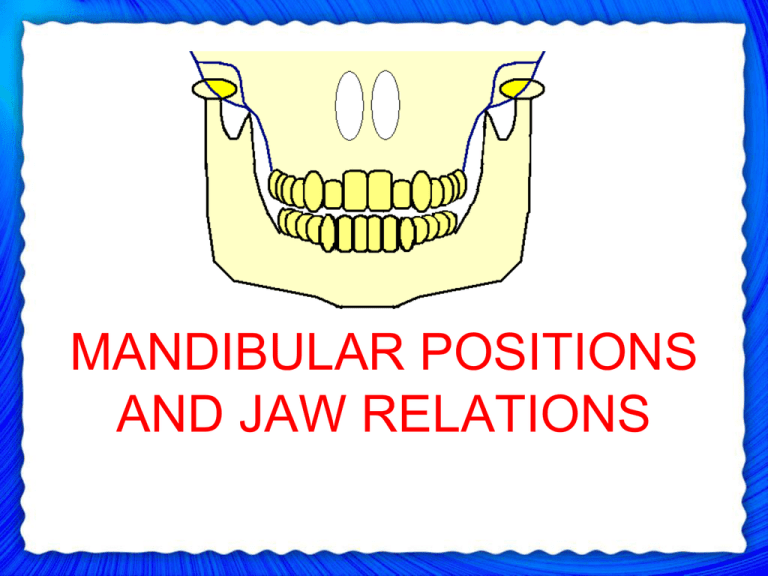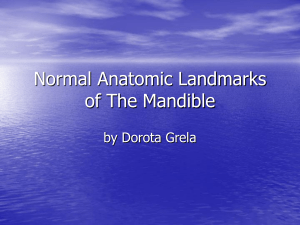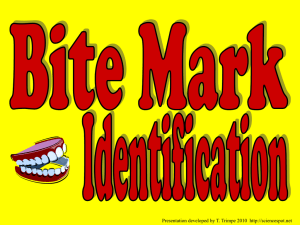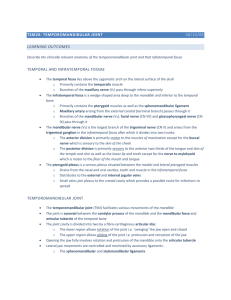introduction to prosthodontics 2nd yr.
advertisement

MANDIBULAR POSITIONS AND JAW RELATIONS Specific learning objectives; • To know about the various mandibular movements, positions, its importance and the clinical applications. • To know about various jaw relations, its importance and the clinical applications. INTRODUCTION • It is important to study mandibular positions and movements as it enables us to plan arrangement of teeth & selection of articulators. COMPONENTS INVOLVED MUSCLES & LIGAMENTS MAXILLA & MANDILBLE TMJ CLASSIFICATION:I) According to Sharry:a) According to direction - Opening and closing movements Protrusion and retraction Lateral gliding movements b) According to tooth contact - Movements with tooth contact Movements without tooth contact c) Limitation by joint structure - Border movements Intra border movements d) Functions of masticatory system - Mastication Deglutition Speech Respiration e) CNS - Innate movements – breathing & swallowing Learned movements – speech and chewing Posselt’s Figure MUSCLES OF MASTICATION • PRIMARY MUSCLES OF MASTICATION – Masseter – Temporalis – Medial Pterygoid – Lateral Pterygoid • SECONDARY MUSCLES OF MASTICATION The suprahyoid group of muscles being used as secondary or supplementary muscles they are – Digastric – Mylohyoid – Geniohyoid MASSETER:- Function ELEVATES RETRUDE MEDIAL PTERYGOID • It is a thick quadrilateral muscle Functions ; 1. 2. 3. When fibers contract the mandible is ELEVATED. Muscle is active in PROTRUDING the mandible. Unilateral contraction will bring about MEDIOTRUSIVE movement of the mandible. TEMPORALIS ELEVATION OF MANDIBLE POSTERIOR FIBER DRAWS MANDIBLE BACKWARDS LATERAL PTERYGOID Superior Lateral Pterygoid:Closing, Retracting Lateral movement in ipsilateral direction • Inferior Lateral Pterygoid:opening protracting Lateral movement in contralateral direction SIDE TO SIDE GRINDING MOVEMENT Medial and lateral pterygoid act together to protrude the mandible DIGASTRICS:• Not considered a muscle of mastication, but it does have an important influence on the function of the mandible. • Divided into 2 portions:– Posterior belly – Anterior belly The combinded efforts of the Digastrics and Lateral Pterygoids provide for natural jaw opening. Terminology Related to Mandibular Position and Tooth Position Basic Premises: • When the mandible closes against the maxilla: 1. There is an ideal way for the teeth to contact 2. There is an ideal place for the condyle and disc to be situated. Terminology Describing Tooth Position: MAXIMUM INTERCUSPATION • Centric Occlusion (CO) • Maximum intercuspation describes an occlusal relationship • Patient finds the most comfortable position • Easily achievable, but not always reproducible, by the patient MAXIMUM INTERCUSPATION What is considered Ideal? – Angle Class I: 1st Molars and Canines relationship – Adequate Overlap – Simultaneous contact – Occlusal Forces along long axis of teeth. Class I • Class I is normal occlusion defined as having the mesiobuccal cusp of the maxillary first molar in occlusion with the buccal groove of the mandibular first molar class II • In the class II occlusion; mandible is retrusive in relation to the maxilla (retrognathic). In this case, the buccal groove of the mandibular first molar will lie distal to the mesiobuccal cusp of the maxillary first molar. class III • If the mandible is protrusive relative to the maxilla (prognathic), then class III occlusion exists. In this case, the buccal groove of the mandibular first molar will lie mesial to the mesiobuccal cusp of the maxillary first molar. Term Describing Mandibular Position CENTRIC RELATION • Centric Relation – A condylar position; Superior and anterior position of the mandible with the disc properly interposed – Describes the most stable position of the condyle Terms Describing Mandibular Position • Centric Relation – Why a superior and anterior position? The Muscles of Mastication drive this process In an Ideal Occlusion, CR and MI Occur Simultaneously. The condyle seats in CR simultaneous with the teeth occluding in MI. No slide occurs. Terms for Describing Eccentric Movements of the Mandible • Protrusive - anterior movement of the mandible • Retrusive - posterior movement of the mandible • Eccentric - movement away from a centric position (CR or MI) Protrusive Terms for Describing Eccentric Movements of the Mandible Lateral movementsmoving the mandible to the left or to the right. Shown is a “left lateral movement” Summary of Characteristics of an Ideal Occlusion ► CR and MI occur simultaneously ► All teeth contact simultaneously ► All occlusal forces are longitudinal ► Posterior tooth contacts dominate Jaw relation/maxillomandibular relation Types: 1. Orientation relation 2. Vertical relation 3. Horizontal relation centric relation eccentric relation—protrusive records ---lateral records. ORIENTATION RELATIONS Orientation relations are those that orient the mandible to the cranium in such a way that when the mandible is kept in its most posterior unstrained position, the mandible can rotate in the sagittal plane around an imaginary transverse through or near the condyles axis passing Vertical jaw relation • Amount of separation b/w maxilla & mandible. • Acc GPT –8. – Distance b/w two selected points one on a fixed and one on a movable member or – The vertical dimension of face b/w any two arbitrary selected points located one above and one below the mouth,usually in the midline. Classification 1. 2. Vertical dimension of occlusion Vertical dimension of rest Vertical dimension of occlusion: (GPT-8) The distance b/w two points when the occluding members are in contact. OR It is the relation of the mandible to the maxilla when the occlusal stops are provided by the teeth/occlusion. Vertical dimension of rest: The distance b/w two selected point measured when the mandible is in the physiologic rest position. INTEROCCLUSAL DISTANCE /INTEROCCLUSAL REST SPACE. • Difference b/w the resting vertical dimension and vertical dimension of occlusion. • First studied by Dr.M E Niswonger • 2-4mm. • Vertical dimension of speech: the distance measured b/w two selected points on each jaw during closest proximity during speech. Horizontal jaw relations Eccentric relation Centric relation Protrusive record Lateral record Centric relation: -- GPT -8 Centric relation is defined as a maxillomandibular relationship in which the condyles articulate with the thinnest avascular portion of their respective disks with the complex in the anterior superior position against the shapes of articular eminences. This position is independent of tooth contact. This position is discernible when mandible is directed superiorly and anteriorly and restricted to a purely rotatary movement about a transverse horizontal axis. Significance of centric relation Ideal arch – arch relationship. Hinge position- only pure rotation without any tanslation Reproducible position- reliable reference Reference position for occlusal reconstruction Two characteristics features of centric relation Reproducible position Untranslated hinge position of mandible Centric relation is the terminal hinge relation Consequences of incorrect centric relation recording Natural dentition– damage to periodontal structure, hypersensitivity, excessive attrition, hypermobility of teeth. Pain & dysfunction of masticatory muscle, headache, neck& shoulder pain. Dentures- not in centric relation— premature contact. TMJ dysfunction— condyle press upon peripheral vascular & innervated part of articular disc. Mucosal irritation & soreness. Spasm of muscle of mastication Resorption of residual alveolar ridges. CONCLUSION • “Nature has blessed us with a marvelously dynamic masticatory system, allowing us to function and therefore exist.” • “ You cannot successfully treat dysfunction unless you understand function.”


